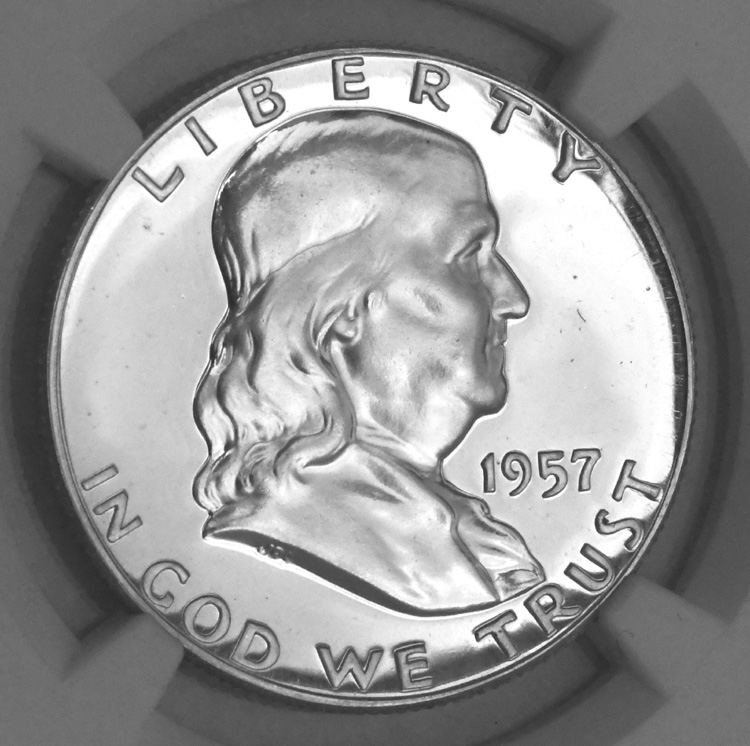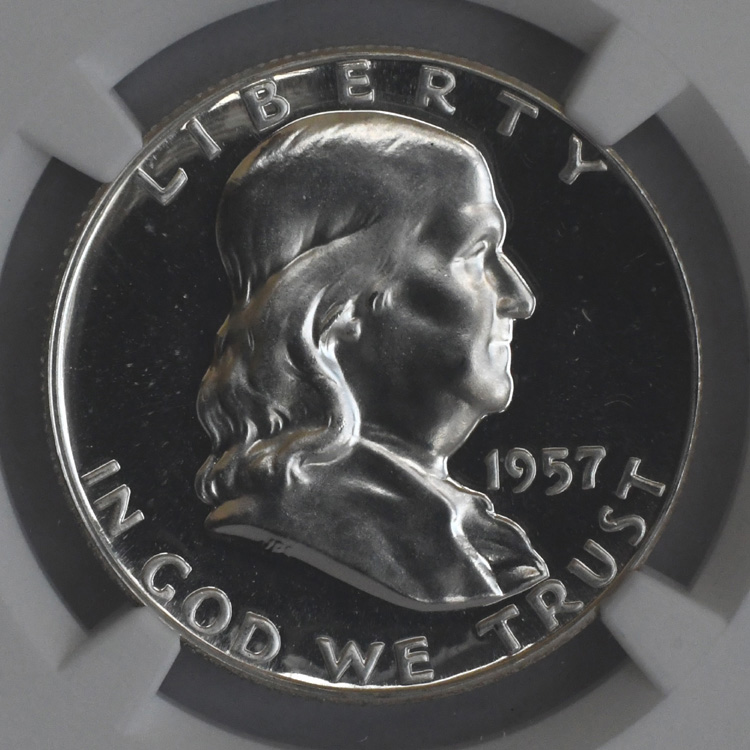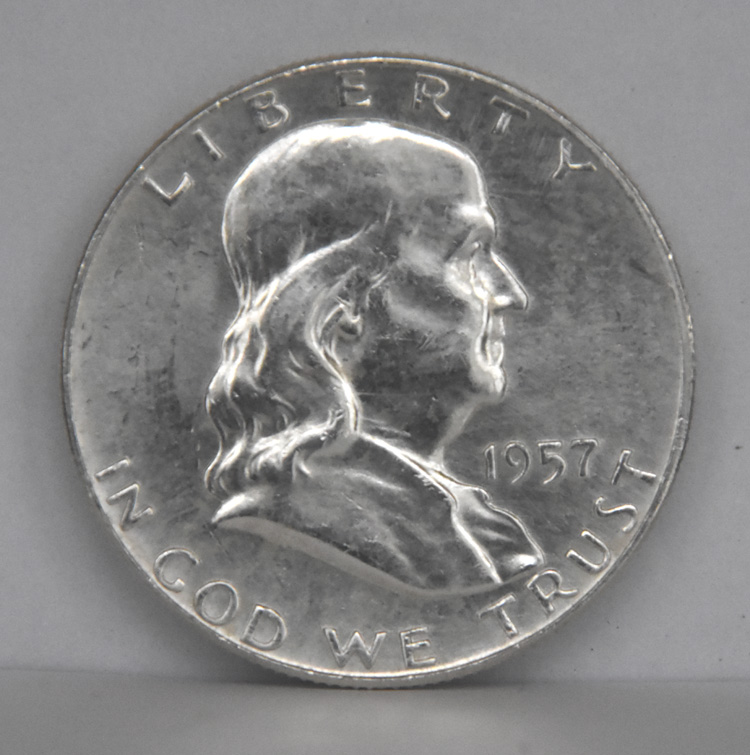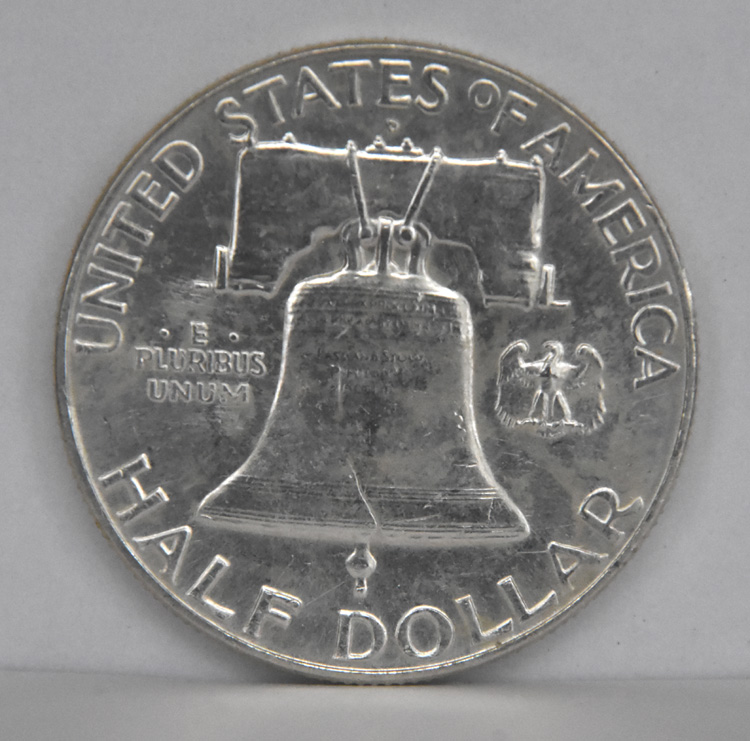Franklin Half Dollar
1948 to 1963
 |
The Franklin half appeared in 1948, having been designed by John R. Sinnock. A large liberty bell is found on the back. The composition and size of the coin are the same as previous designs. These coins are widely available and throughout its history, the Franklin half remained remarkably constant in value. Only a few uncirculated issues command a higher price, notably the 1949 D coin, which in perfect condition might cost as much as $1000. The composition is the same as previous issues, being about 90% silver. |
 |
| This is a proof coin, certified by NGC as a 67, and worth about $70. It is stored in the red box. | This is the same coin, with different lighting to show the cameo background. | |
 |
|
|
| My 1957example above is almost uncirculated. It cost me $0.50 and today, it's worth about $15. I have a number of these coins in circulated condition that I got for $0.50 each from banks in the 60's, and each one is now worth at least $10. And I do have a complete album of these coins in extra fine condition. | This is the reverse of the coin at left.
|
| 1957: January 6: Elvis Presley appears on The Ed Sullivan Show for the 3rd and final time. He is shown only from the waist up, even during the gospel segment, singing "Peace In The Valley". Ed Sullivan describes Elvis thus: "This is a real decent, fine boy. We've never had a pleasanter experience on our show with a big name than we've had with you. You're thoroughly all right." January 13: Wham-O Company produces the first Frisbee. January 14: American screen actor Humphrey Bogart dies aged 57 in California, after a long battle with cancer. January 23: Ku Klux Klan members force African-American truck driver Willie Edwards to jump off a bridge, into the Alabama River; he drowns as a result. January 31: Three students on a junior high school playground in Pacoima, California, are among the 8 persons killed, following a mid-air collision between a Douglas DC-7 airliner and a Northrop F-89 Scorpion fighter jet, in the skies above the San Fernando Valley section of Los Angeles, U.S.A. February – 1957–58: Influenza A virus subtype H2N2, first identified in Guizhou province of China, spreads to Singapore. It reaches Hong Kong by April and the United States by June, killing at least 1 million people worldwide. February 4: The first nuclear-powered submarine, USS Nautilus, logs its 60,000th nautical mile, matching the endurance of the fictional Nautilus described in Jules Verne's 1870 novel Twenty Thousand Leagues Under the Sea. February 17: A fire at a home for the elderly in Warrenton, Missouri, kills 72 people. March 1: Dr. Seuss' The Cat in the Hat is published in the United States. March 13: The United States Federal Bureau of Investigation arrests labor union leader Jimmy Hoffa, and charges him with bribery. March 26: Elvis Presley buys Graceland, on 3734 Bellevue Boulevard (Highway 51 South), for $US100,000. He and his family move from the house on 1034 Audubon Drive. March 31: Rodgers and Hammerstein's Cinderella, the team's only musical written especially for television, is telecast live and in color by CBS in the United States, starring Julie Andrews in the title role. The production is seen by millions, but this 1957 version is not to be telecast again for more than 40 years, when a kinescope of it is shown. April: IBM sells the first compiler for the Fortran scientific programming language. May 3: Brooklyn Dodgers owner Walter O'Malley agrees to move the team from Brooklyn, New York, to Los Angeles. May 15: At Malden Island in the Pacific, Britain tests its first hydrogen bomb, which fails to detonate properly. May 22: A 42,000-pound Mark 17 hydrogen bomb accidentally falls from a United States bomber, near Albuquerque . June 15: Oklahoma celebrates its semi-centennial statehood. A brand new 1957 Plymouth Belvedere, named Miss Belvedere, is buried in a time capsule, to be opened 50 years later on June 15, 2007. June 27: Hurricane Audrey demolishes Cameron, Louisiana, U.S., killing 400 people. July 6: John Lennon and Paul McCartney first meet as teenagers at a garden fete at St. Peter's Church, Woolton, Liverpool, England, at which Lennon's skiffle group, The Quarrymen, is playing, 3 years before forming The Beatles. July 9: Elvis Presley's film Loving You opens in theaters. July 16: United States Marine Major John Glenn flies an F8U supersonic jet from California to New York in 3 hours, 23 minutes and 8 seconds, setting a new transcontinental speed record. July 28: Heavy rains and mudslides at Isahaya, western Kyūshū, Japan, kill 992. A strong earthquake shakes Mexico City, and Mexican port city Acapulco. August 21: U.S. President Dwight D. Eisenhower announces a 2-year suspension of nuclear testing. August 28: United States Senator Strom Thurmond (D-SC) sets the record for the longest filibuster, with his 24-hour, 18-minute speech railing against a civil rights bill. September 4: Governor Orval Faubus of Arkansas calls out the National Guard of the United States, to prevent African-American students from enrolling in Little Rock Central High School. he Ford Motor Company introduces the Edsel, on what the company proclaims as "E Day". September 14: Have Gun – Will Travel premieres on CBS. September 21: Perry Mason premiers on CBS. September 23: The Academy Award-winning movie The Three Faces of Eve is released. September 26: Leonard Bernstein's musical West Side Story makes its first appearance on Broadway, and runs for 732 performances. October 2: David Lean's film The Bridge on the River Kwai opens in the U.K. October 4: The Soviet Union launches Sputnik 1, the first artificial satellite to orbit the earth. October 10: Ayn Rand's fourth, last and longest novel, Atlas Shrugged, is published in the United States. October 11: The Jodrell Bank radio telescope opens in Cheshire, England. The orbit of the last stage of the R-7 Semyorka rocket carrying Sputnik I is first successfully calculated on an IBM 704 computer at the MIT Computation Center as part of Operation Moonwatch, Cambridge, Massachusetts. October 16: Antônio Vilas Boas, a Brazilian farmer, claims to have been abducted by extraterrestrials; the first famous alien abduction case. October 31: Toyota begins exporting vehicles to the United States, beginning with the Toyota Crown and the Toyota Land Cruiser. November 3: The Soviet Union launches Sputnik 2, with the first animal to orbit the Earth, a dog named Laika on board; there is no technology available to return it to Earth. November 7: In the United States, the Gaither Report calls for more American missiles and fallout shelters. November 8: The film Jailhouse Rock opens across the U.S. to reach #3, and Elvis Presley continues to gain more notoriety. November 13: Gordon Gould invents the laser. November 16: Serial killer Edward Gein murders his last victim, Bernice Worden of Plainfield, Wisconsin, U.S. December 6: The first U.S. attempt to launch a satellite fails, when the Vanguard rocket blows up on the launch pad. December 18: The Bridge on the River Kwai is released in the U.S. It goes on to win the Academy Award for Best Picture. December 19: Meredith Willson's classic musical The Music Man, starring Robert Preston, debuts on Broadway. December 22: The CBS afternoon anthology series The Seven Lively Arts presents Tchaikovsky’s ballet The Nutcracker on U.S. television for the first time, although heavily abridged. Mao Zedong admits that 800,000 "class enemies" had been summarily liquidated in China, between 1949 and 1954. |
